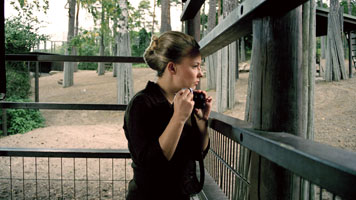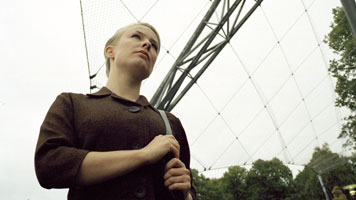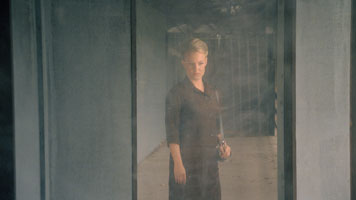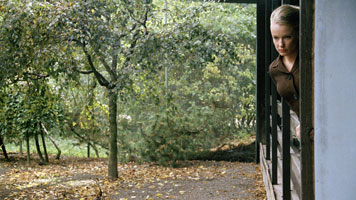4 May – 25 June
Zoo
Video Installation
Projection of the Trilogy Cave
Show opening Wednesday 3rd May starting at 6 p.m.
Tuesday - Sunday, noon to 6 p.m.
"I have wondered about the way people see their lives. If you close your eyes and then use your memory, it's like a film."
Debate with Francis McKee, in Salla Tykkä, NIFCA publication 09, 2001

Zoo, Salla Tykkä's latest film, resembles her previous ones in that the piece tells an enigmatic tale that keeps us on the edge of our seats, points to a referenced film genre whose codes are commonly used, magnifies the gaze, and in the process offers us singularly beautiful images. What strikes one as well, both in the trilogy Cave (the trilogy is made of Lasso, 2000, Thriller, 2001, Cave, 2003) and Zoo, is the absence of any dialog, the emotional force of the music, and the fact that the principal role goes to a female figure who alone changes her behavior over the course of the film while the other characters go about their business, seemingly indifferent or absorbed by what they are doing.
Zoo takes place in a zoo, that half-wild half-constructed setting that is both untamed and controlled. A woman wearing her blonde hair in a bun, dressed in a dark pantsuit and wielding a camera, plunges into this territory and its strange character. The camera follows her and the views are often shot through fencing, nets, or glass panes, or are framed by gates. The music composed for the film instantly creates a certain tension, a suspense that is reinforced by the movements of the film camera, which is dramatically echoed by the still camera. This duality is a component of the film.

During her stroll through a zoo that is devoid of any other visitor, the woman shoots photographs. Her eye is thus replaced by ours for we see whatever she is aiming her lens at. The first image we discover certainly comes as a surprise: the shot, taken from under water and against the light, shows us an immobile floating body. We eventually gather that the view is of a female rugby player, part of a rugby team shown playing underwater. Nothing seems to unite these two worlds other than the gaze of both the woman and the viewer, who make them coexist.
These scenes of aquatic struggles have exceptional dramatic power, undermining "the reality of what is above" and introducing the idea of a "reality of what is below," or unconscious. They are regularly inserted throughout the film, punctuating the woman's walk and disturbing our perception of events.
The story continues like this: the woman observes her surroundings, looks back, photographs various animals; the tension mounts and she seems to be worried, then to panic. The rhythm picks up, she is hunting for something or looking to run off, appears to find a way out. Giving up that intermediary eye that is the camera, she dives into the water to reach the other world and we can only speculate as to what it means to her and to us in return.
There are lots of analyses of Tykkä's oeuvre inspired by gender studies, theories about feminism or the gaze, Freudianism or Lacanian psychology, or describing the artist's autobiographical relationship to her work, placing it in the tradition of the self-portrait. Her films certainly call for these and other interpretations; they also show a clear affinity with film, its strategies and the quality of its images. Tykkä knows popular genres like the western, the thriller, or science fiction, and admirably distills the atmospheres and emotions that are peculiar to these typologies, projecting us into their worlds in a few deft minutes. She draws on the genre's vocabulary and especially reworks the rhythm against which she determines her camera movements and the length and framing of her scenes, and bases her pieces on the one element that directly aims for our emotions, namely, music (in Lasso, Once upon a Time in the West (1969) directed by Sergio Leone,with the gorgeous Claudia Cardinale, for Thriller, two references : Halloween (1979) directed by John Carpenter and Carrie (1979) by Brian de Palma, in which both the heroine is an adolescent, and for Cave, the music from the very enigmatic science-fiction movie Dune (1984) by David Lynch ). Thus, if Lasso borrows from the western, Thriller from the horror film, and Cave from science fiction, Zoo clearly refers to the films of Alfred Hitchcock, their atmosphere, share of unresolved mysteries, and female characters (the blonde woman is based on Kim Novak and Tippi Hedren).

Yet her work involves neither western, thriller, nor Hitchcockian tale but rather the typical atmosphere these give off, grabbing the viewer. He or she is seized by the emotion, "caught up" in the film. However, from a strictly narrative point of view, the piece of fiction unfolding before us contains nary an iconographic element that would identify it with the genre being portrayed (Lasso doesn't tell a western story or indeed any story that supposedly belongs to the genre). Between the fictional story, which is constructed by the images, and the staging of it, which borrows from the codes and the rhythm that are peculiar to one of these genres, the values and ideology that spread the genre in question intermittently appear, each conveying and molding a particular view of the world.
And it is this gaze that Tykkä flushes out. Films, for both the silver screen and TV, reflect the trends and relations of power that society has put in place, confirm and produce our gaze, format our dreams, expectations, and emotions, and they do so both in reality and at the movies.
"... I became interested in the relationship between the moving images and reality. I was intrigued by the immaterial nature of film and video and their ability to resemble reality and its elements, such as dreams and memories. I thought that films could form a part of personal experience and memory, and steer a person's conception of him- or herself and the world."
Salla Tykkä, January 2004 in Salla Tykkä, Cave, X/rummet Statens Museum for Kunst , 7. Februar – 25. April 2004
Tykkä therefore highlights a certain way of seeing, which she couples with an epiphany. The conscious presentation of the gaze and its iconographic attributes—the reflecting surfaces, the window, the lens—structure the story's progress while referring to a series of dualities, i.e., the opposition of the outside and inside worlds, or that of seeing and being seen, etc., which determines its interpretation. These dual contexts create the dynamics of the transformation. From one film to the next the female figures evolve, change the gaze they turn on those around them, and in return modify the perception and image they have of themselves. They acquire an individual freedom, which is moreover confirmed by the liberties they all take with respect to the story that ought to be unfolding, displacing one's expectations vis-à-vis the supposed content of the piece, ready to meet the challenge of a new role.
This exhibition will present the work Zoo and project the trilogy Cave (Lasso, 2000, Thriller, 2001, Cave, 2003)
Isabelle Aeby Papaloïzo

Salla Tykkä was born in Helsinki in 1973. She still lives and works in this city.
Solo Exhibitions
2005
A Whiter Shade of Pale, Kunstraum Hüll, Hüll, Germany
2004
Finnish Institute, Stockholm, Sweden
Portikus, Frankfort, Germany Fact, Liverpool, UK Cave, Statens Museum for Kunst, Copenhag, Danmark
2003
Happy Days, Collection Lambert, Avignon, France Tensta Konsthall, Stockholm, Sweden
The Institute of Visual Arts, Milwaukee, U.S.A
Museo de Arte Carillo Gil, Mexico, Mexico
Distance, Künstlerhaus Bethanien, Berlin, Germany
Cave, Tramway, Glasgow, UK
Herbert F. Johnson Museum of Art, Ithaca, U.S.A
2002
Thriller, Kiasma, Museum of Contemporary Art, Helsinki, Finland Pain, Pleasure, Guilt, Bawag - Foundation, Vienne, Austria
Kunsthalle Bern, Berne, Switzerland
Hidden Forces, Galerie Yvon Lambert, Paris, France
2001 Lasso, Delfina Project Space, London, UK
1999 Power, Studio Mezzo, Helsinki, Finland
1997 Healthy Young Female, Gallery of the Academy of Fine Arts, Helsinki, Finland
Group Exhibitions (selection)
2005
Selbstauslöser, Kunsthalle Fridericianum, Kassel, Germany
Self Discipline, Overgaden, Copenhag, Danmark
2004
Down Here, Bergen Kunsthall, Bergan, Norway
Louisiana Museum of Modern Art, Danmark
Nuclear war, Kunsthaus Dresden, Dresden, Germany Gokann, Kunsthalle Helsinki, Helsinki, Finland
A Fripon, Fripon et demi, Collection Lambert, Avignon, France
2003
Girl's night out, Orange County Museum of Art, Newport, U.S.A Girls don't cry, Parco Museum, Tokyo, Japan
Transparente, Museo Nazionale Delle Arti del XXI secelo, Rome, Italy
New Realities, Hasselblad Center, Gothenburg, Sweden
The Squared Circle, Walker Art Centre, Minneapolis, U.S.A
2002
Edstrandska Nordiska Stipendium, Malmö Konsthall, Sweden Power, Casino Luxembourg, Luxembourg
Les Enfants du Paradis, Galerie Yvon Lambert, Paris, France
Centre of Attraction, Contemporary Art Centre, Vilnius, Lituania
ArtUnlimited, Basel, Switzerland
Greyscale/CMYK, Tramway, Glasgow, UK
Kenen jäljillä?, Salo Art Museum, Salo, Finland
Fantasies, Sara Hildén Art Museum, Tampere, Finland
Beyond Paradise, Bangkok, Thailande / Kuala Lumpur, Malaisia
2001
Trans Sexual Express, Budapest, Hongrie / A Coruña, Spain Voltti, The Lönnström Art Museum, Rauma Art Museum, Rauma /
The Finnish Museum of Photography, Helsinki, Finland
Identity, Oulu Art Museum, Oulu, Finland
Trans Sexual Express, Centre d'Art Santa Mònica, Barcelone, Spain
La Biennale di Venezia, Venise, Italy
Rock the Campo, Venise, Italy
BIDA, Valence, Spain
2000
Master Degree Show, The Academy of Fine Arts, Helsinki, Finland Beauty Queens, Art Centre Ahjo, Joensuu, Finland
Prizes and Nominations
2004 Nomination for ArsFennica prize, Finland
2002 Edstrandska Nordiska - Stipendium, Sweden
2002 DZ Bank -Prize, Germany
2002 Honourable Mention (Lasso), S Media City Artate / Hot, Ontario, Canada
2001 Nomination for Gilles Dusein Prize, France
